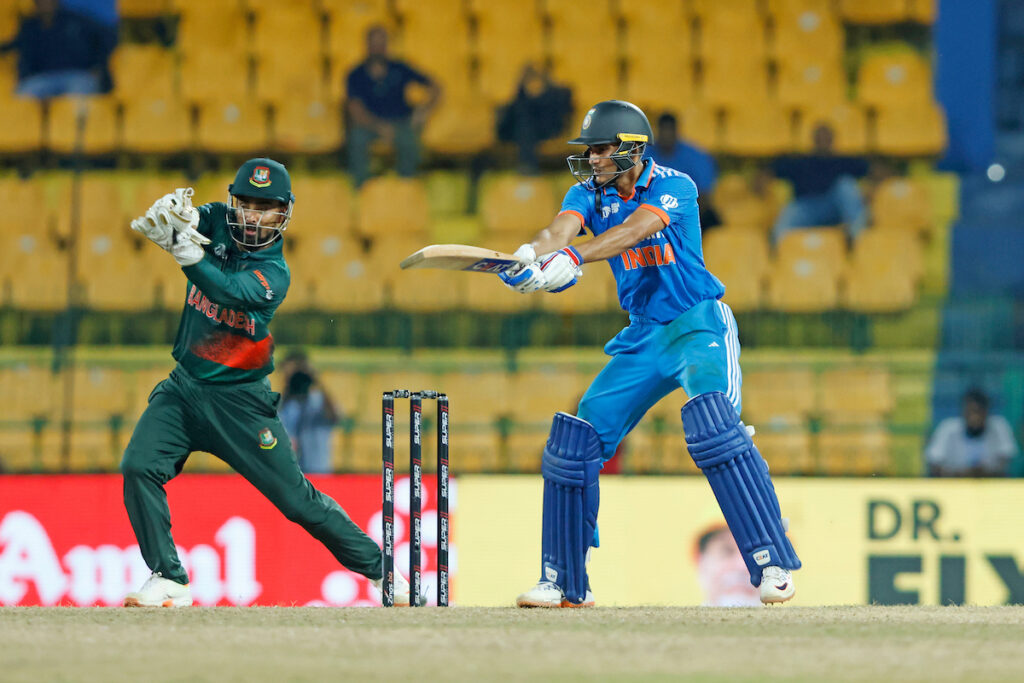
Colombo
The lofted shot by an Indian opener in a Super Fours game versus Bangladesh had excellence associated with it. On 48, Gill timed his charge down the deck to perfection, giving very little time for Mehidy Hasan to adjust his line or length, and deposited it wide of long-on. Although the matchup of a right-handed batter facing an off-spinner suits the former, there is still an element of risk in leaving the crease. Not so for Gill.
He repeated the shot three more times: Once against Shakib Al Hasan and twice while facing Mehidy. Even when he wasn’t exactly to the pitch of the ball, he didn’t lose the shape of his shot as he smacked Shakib into the stands.
Most of his other shots too seem to be safely kept it in a locker, which he can withdraw whenever he wants to, and use it on the field. It is true that when he brings out the pull stroke, he plays with a dash of cowboy-style approach. The pull, however, is one of his favourite strokes, and in that context, it is still a low risk shot for Gill.
On a humid night at Premadasa, only a bit of fatigue could have stopped Gill. And that is what perhaps finally took its toll on the opener. With India also losing wickets at regular intervals and the required run-rate at over nine runs per over, Gill began to take more risks. He once succeeded while facing Mahedi Hasan. Mahedi, however, had the last laugh, as he bowled one wide of off-stump and Gill could only spoon a catch to the fielder positioned at long-off.
If you scratch the surface to get the bigger picture, Gill has three key strengths in the 50-over format. He can pace the innings, alongside playing a slew of largely risk-free shots. The icing on the cake is Gill also has an extra boost button in his repertoire. No wonder, in just 32 ODIs, Gill has essayed five hundreds, including a double ton, and averages over 60 in that format.
That double ton came in Hyderabad. It was an innings that perfectly illustrates how Gill goes about playing an ODI innings. At one point, he was on 53 off 53 deliveries. When he reached the three-figure mark, his strike rate was 113. When he reached the 150-run mark, his strike rate had further improved to 124. And when he was eventually dismissed, it stood at 139.6.
For a moment or two, also transport yourself back to the IPL this year. In the crucial games against Mumbai Indians and Royal Challengers Bangalore, how did he accumulate a sizeable portion of his runs? Pulls, lofts, cuts and punches, blended with the occasional sweep. Did he try fancy shots like the reverse-hit, reverse-sweep or the scoop? Hardly, if any. Yes, the format was different, but the foundation stone of Gill’s game remained the same – He can play largely a risk-free game in the abridged versions and still score at a very healthy strike rate.
Although Gill has been working on how he initially loads up, the longest format still seems to be a bit of an Achilles’ heel for him. In ODIs, however, the two white Kookaburra balls don’t move around for long. And the format is perfectly suited to how Gill goes about constructing his innings.
It isn’t just the Asia Cup final. With the World Cup also on the horizon, the think-tank would be trusting Gill to become one of the fulcrums of the batting order. Who knows? He could just end up playing a game-changing knock in a World Cup final at his happy-hunting hundred.



